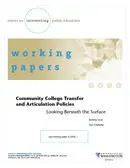As the demand for higher education has grown, so has the role of community colleges in providing post-secondary education to students. The development of curriculum articulation and school transfer policies is one policy movement that demonstrates the extent to which state policymakers view community colleges as creating greater and broader access for students. Recent research suggests that the presence of a state articulation and transfer policy does not increase the transfer rate of community college students to four-year institutions. However, all such policies are not the same—so we must account for more than just the presence of these policies when assessing their impact, and account for the mechanisms through which they encourage or facilitate student transfers.
We attempt to address this gap in this paper by exploring the relative importance of specific policy components (such as common course numbering or common general education requirements) on post-secondary outcomes, and how such policies differently impact students with different aspirations or economic and ethnic backgrounds. In addition, we explore how the potential impacts of these policies compare with some institution-level policies such as support for tenured faculty, expenditures for student services, or expenditures for instruction. In the end, we find only small effects—concentrated amongst Hispanic students—that state transfer and articulation policies are related to the transfer of students between sectors. In terms of general effects across students, institutional factors regarding faculty tenure at community colleges seem to be more correlated to the propensity of students to transfer between community colleges and four-year institutions.





